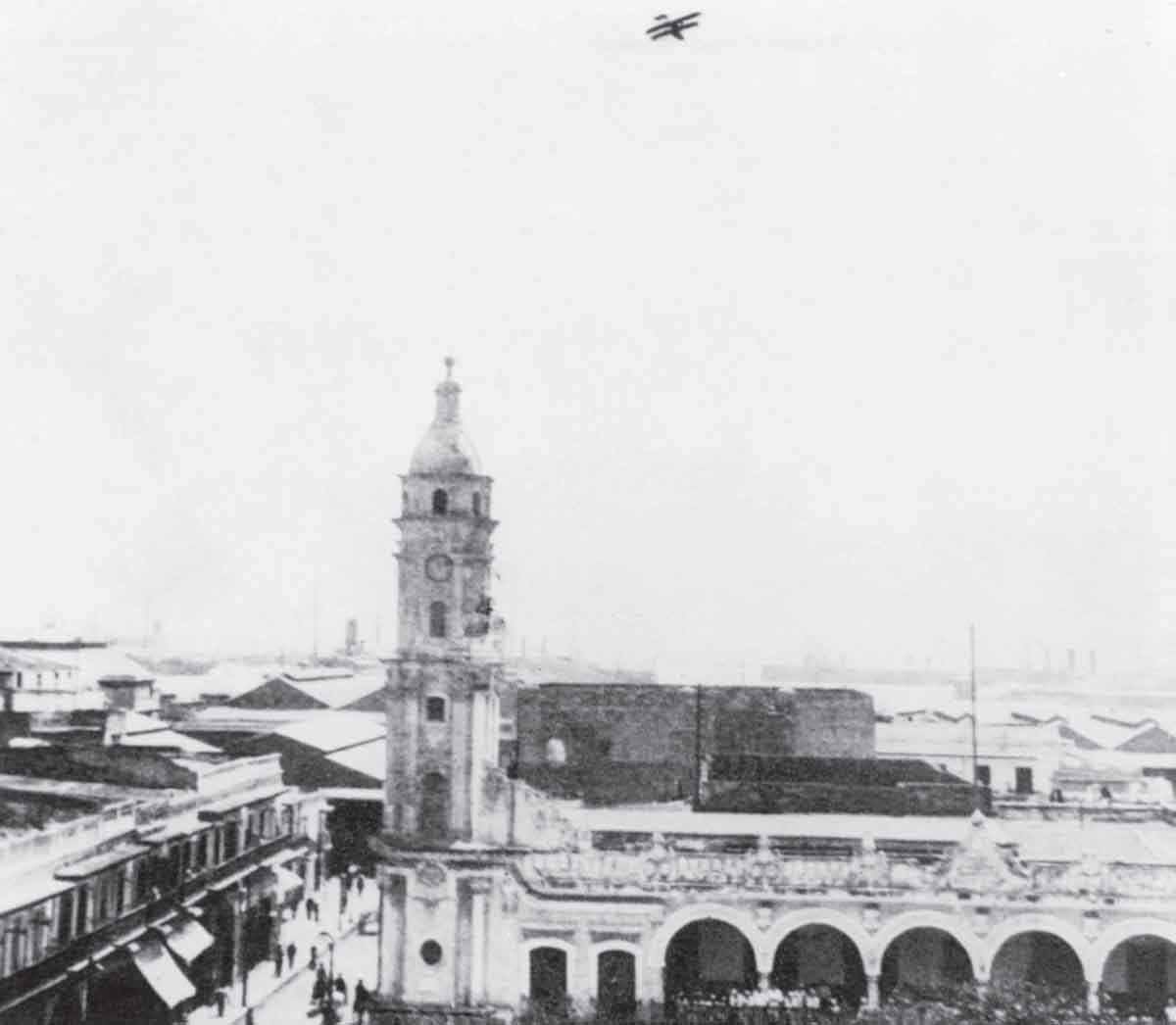
USN aircraft flying over Veracruz with USN ships at anchor in the harbour.
Crew about to go on an aerial flight over Veracruz.
Lieutenant Bellinger’s aircraft being lowered into the water for an observation flight
Lieutenant Commander Mustin went on deck to inspect the facilities required for such a mission. The USS Birmingham had been in the public eye on 14 November 1910 when Eugene Ely had flown a Curtiss pusher from her deck, only this time aircraft were going to have to fly from her deck under battle conditions. If successful, it would be a great boost for naval aviation; if not, it could spell the death knell. However, it was decided to use floatplanes instead as the ships would be anchored off Veracruz. After his initial inspection, Mustin realized that the ship had no facilities for hoisting the aircraft in or out of the water, so lowering booms were quickly installed on the mainmast to serve as derricks.
The unstable situation in Mexico suddenly reached its zenith when a message was received in Washington that a German merchant ship was to dock on 21 April at Veracruz with a cargo of weapons and ammunition for General Victoriano Huerta’s troops.
The USS Birmingham, with an aviation detachment aboard consisting of three pilots, three aircraft and twelve enlisted men all under the command of Lieutenant John H. Towers, was immediately dispatched to join the Atlantic Fleet forces operating off the coast of Tampico. Meanwhile, the USS Mississippi, under the command of Rear Admiral Frank Jack Fletcher with a second aviation detachment aboard, was dispatched to assist in the military operations at Veracruz. On 21 April 1914, the Fleet landing force lost nineteen men to snipers from the revolutionary army when they attempted to seize Veracruz.
The city of Veracruz was a contrast of extremes. The pastel-painted buildings with their green and pink balconies set against a background of deep azure blue skies presented a beautiful sight, but the vast majority of the city had no sanitation, disease was rampant and the whole area reeked repulsively of rotting refuse and human waste. This cesspool of a city was what the US Navy and Marines were about to try to take.
The USS Mississippi launched her first observation flight, an AB-3 flying boat flown by Lieutenant (junior grade) P.N.L. Bellinger, over the harbour of Veracruz to search for mines. Two days later Bellinger made a second flight, this time accompanied by an observer Ensign W.D. LaMont, to photograph the harbour.
On 2 May 1914, the USS Mississippi launched a third flight, this time in a Curtiss C-3 (AH-3) floatplane, to search for enemy troops reported near El Tejar. After flying for more than fifty minutes they returned to the ship having seen nothing but American army troops, but what they had done was record the first American aerial mission under military conflict conditions. Four days later, on 6 May 1914, Bellinger, with Lieutenant (junior grade) Saufley as observer, flew a reconnaissance flight over enemy positions near Veracruz. Their aircraft was hit by rifle fire from the ‘invisible’ enemy; the first marks of combat on a US naval aircraft.
Over the next few days, Bellinger and Saufley carried out several more observation flights over the town, more as a show of strength than a serious threat, but fortunately without any further incidents. The flights were merely token gestures in support of the ‘bluejackets’ who were already in the town mopping up resistance.
The results from the Veracruz incident made nonsense of the attempt to provide air support for ground troops, and highlighted the lack of commitment at the time by the American government to the future of air power. However, it did spur the aircraft manufacturers (only twelve of the manufacturers were capable of producing what could loosely be called military aircraft at that time) into later looking at the problem with serious intent. Some 400 aircraft were produced during 1916, and not one could be considered to be a pure military aircraft.
An aviation camp was set up on the beach and the work of scouting the area continued. After flying a number of missions during the next month with no results, the number of flights was reduced to one per day. The crews of the aircraft were looking for ghosts and they knew it. The navy felt that it was a waste of time and effort to continue, but were told that they would have to stay until the army was able to get some of their Air Service aircraft there. However, this was not the first time aircraft had been considered for use in a military capacity against the Mexicans. The first recorded use was in February 1911 when a US government pilot carried out a reconnaissance flight over the rebel forces at Ciudad Juárez but did not carry out any aggressive action.